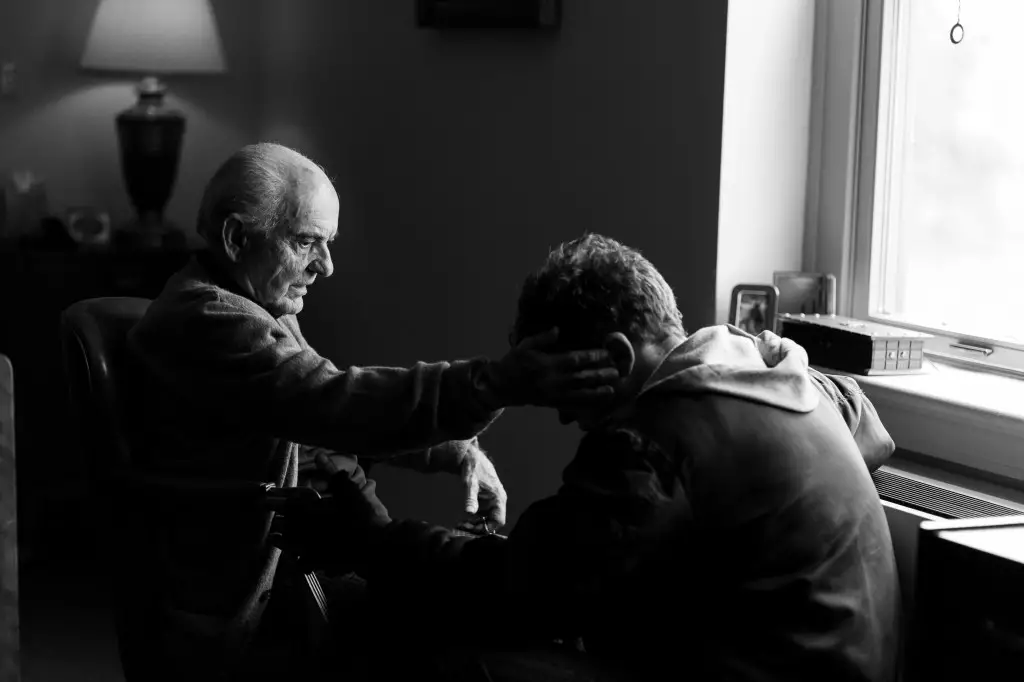There has been a significant amount of discussion around nepotism in the film industry as of late, but it is essential to determine if there is genuine talent present rather than simply dismissing individuals due to their lineage. Jack Huston, a 40-year-old charming and handsome man, finds himself under scrutiny as a fourth-generation member of the illustrious Huston family. However, his directorial debut, “Day of the Fight,” which premiered in the Horizons Extra section of the Venice Film Festival, stands as a testament to his abilities. While the film can sometimes be earnest and excessively style-conscious, Huston’s focus on performance over story gives it an emotional resonance that earns it a place among the family’s esteemed works.
Jack Huston arguably achieves a flying start with his casting choice of Michael Pitt. Known for his remarkable performance in Larry Clark’s “Bully,” Pitt brings vulnerability to his roles that shines through in his portrayal of Irish Mike, a former middleweight champion who has become a recluse. The film, set in the mid-80s and shot in black and white to lend an air of nostalgia to the newly gentrified Brooklyn, follows Irish Mike as he prepares to make a comeback for a prestigious title fight at Madison Square Garden.
“Day of the Fight” centers around the events leading up to the championship bout, employing extensive flashbacks to provide insight into Irish Mike’s motivations. On this eventful day, Irish Mike visits various locations, each revealing a piece of his troubled past. He stops outside a Catholic girls’ school to catch a glimpse of his estranged daughter, retrieves his mother’s wedding ring from his uncle (portrayed in a brief cameo by Steve Buscemi), pawns it, and places a substantial bet on himself with the proceeds. Irish Mike also revisits his old gym and encounters his gruff yet caring trainer, Stevie (played excellently by Ron Perlman). In a poignant moment, he visits a church to reunite with an old friend who has become a priest. Lastly, he pays a visit to his abusive father, now suffering from dementia, creating a chain of events that unveil the tragedy that led to Irish Mike’s downfall.
During the film’s first hour, Jack Huston’s “Day of the Fight” echoes Martin Scorsese’s “Mean Streets,” embodying the sentiment that redemption is achieved in the streets rather than the church. There is even the suggestion that Irish Mike might have seen Scorsese’s film, providing a subtle homage. Astonishingly, Huston dares to navigate the territory of “Raging Bull,” delving into the world of boxing with a memorable fight sequence that rivals Scorsese’s masterpiece. Here, Huston’s focus on performance shines through, and Michael Pitt delivers a committed and transformative performance, solidifying his director’s faith in him.
Despite its promising aspects, “Day of the Fight” does not revolutionize the genre, and the weight of the $7K bet looms heavily throughout the film. Two possible outcomes exist for this high-stakes bet, establishing tension similar to that explored in the Safdie brothers’ “Uncut Gems.” On this basis, it could be argued that storytelling emerges as the film’s Achilles’ heel. However, Huston exhibits immense promise as a director when working with actors. One standout scene finds Irish Mike interacting with a young Black girl in the projects, showcasing the director’s ability to draw powerful performances even from young talents.
Music plays a significant role in “Day of the Fight.” The film features carefully chosen needle-drops, including tracks by Jackson C. Frank and Sixto Rodriguez. Additionally, a melancholy piano rendition of Creedence Clearwater Revival’s timeless classic, “Have You Ever Seen the Rain,” emerges as a poignant accompaniment to the story. Of particular note is Huston’s inclusion of Joe Pesci’s own music to create a moving backstory for Irish Mike’s bitter and failed singer father. This artistic decision elevates the film, presenting audiences with a deeper understanding of the characters’ motivations and emotions.
A hint of Abel Ferrara’s influence can be detected in Irish Mike’s destiny. However, Jack Huston, a man who sees the glass as half full, steers the film away from a similar dark path. “Day of the Fight” concludes with a traditional introduction of color that exudes a distinct Hollywood optimism, albeit one that does not entirely ring true. Similarly, certain elements of Irish Mike’s bleak narrative may not completely convince viewers (for example, the fact that his last-chance fight is televised). Nonetheless, the film possesses a soulful charm, with Huston’s artistic attempts to match Jackson C. Frank’s haunting lyrics for “Blues Run the Game,” expressing the hope that tomorrow may bring an end to one’s struggles.
In conclusion, “Day of the Fight” allows Jack Huston to showcase his promise as a director. While the film has its flaws, it stands as a confident and imaginative calling card, worthy of the esteemed Huston family name. Huston’s ability to draw compelling performances from actors, coupled with his keen sense of music, creates a film that resonates emotionally with viewers. As Jack Huston carves his own path in the film world, “Day of the Fight” serves as a promising debut that leaves audiences eager to see what he has in store for the future.

